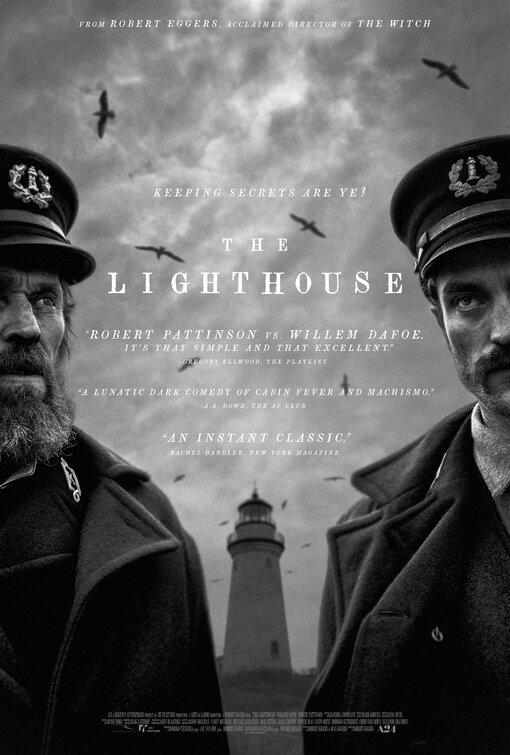
![]() I loved director Robert Eggers’ debut The Witch back in 2015. His follow-up really doubles down on the lo-fi art house pretensions of his directorial debut. Not only is it shot in black and white but it also presents a 1.19:1 aspect ratio reducing the screen down to an almost perfect square. Furthermore, it’s another period piece this time set more than 200 years later in 1850 and it relies on the dialect and colloquialisms of the era. Eggers co-wrote the script along with his brother Max Eggers. The screenplay was heavily influenced by the 19th-century writings of author Sarah Orne Jewett. The thick drawl of the dialogue can get a bit impenetrable to our 21st-century ears. Lastly, this two-hander stars current indie idol Robert Pattinson (Cosmopolis, Good Time) as well as eccentric indie notable Willem Dafoe (The Florida Project, At Eternity’s Gate). Each actor often gravitates toward inscrutable fare. This film is a prime example. As two bona fide movie stars should, they fully commit to their characters by bringing their A-game. If nothing else, their performances are intense. It’s still a challenging watch.
I loved director Robert Eggers’ debut The Witch back in 2015. His follow-up really doubles down on the lo-fi art house pretensions of his directorial debut. Not only is it shot in black and white but it also presents a 1.19:1 aspect ratio reducing the screen down to an almost perfect square. Furthermore, it’s another period piece this time set more than 200 years later in 1850 and it relies on the dialect and colloquialisms of the era. Eggers co-wrote the script along with his brother Max Eggers. The screenplay was heavily influenced by the 19th-century writings of author Sarah Orne Jewett. The thick drawl of the dialogue can get a bit impenetrable to our 21st-century ears. Lastly, this two-hander stars current indie idol Robert Pattinson (Cosmopolis, Good Time) as well as eccentric indie notable Willem Dafoe (The Florida Project, At Eternity’s Gate). Each actor often gravitates toward inscrutable fare. This film is a prime example. As two bona fide movie stars should, they fully commit to their characters by bringing their A-game. If nothing else, their performances are intense. It’s still a challenging watch.
The Lighthouse has been described as psychological horror which is a nice description for a movie that traffics in an unsettling milieu without actually being scary. On the surface, it’s a story about two co-workers forced to live together in a remote lighthouse on a tiny New England island. They’re supposed to be there for four weeks until their replacements show up. Thomas Wake (Willem Dafoe) and Ephraim Winslow (Robert Pattinson) are roommates that don’t get along and their deteriorating relationship is the plot. Thomas Wake is the old salt in charge and he makes life absolutely miserable for his young protege. For the most part, the taciturn Winslow does what he is told. The abusive Wake burdens Winslow with an inordinate amount of chores, forces him to drink, frequently passes gas and spends time with (ahem) himself. Wake’s repulsive behavior offends Winslow. Wake seems completely unstable — a taskmaster obsessed with power. At one point Wake angrily demands that Winslow make the lighthouse “sparkle like a sperm whale’s pecker!” The line reads as ridiculous as it sounds. It was then that I realized I was watching a comedy albeit one inspired by the visual style of Sven Nykvist.
The pictorial tableau is crammed with haunting images. They compel the viewer to remain riveted to the screen. Indeed the cinematography is the most attractive feature of the spectacle. Director of photography Jarin Blaschke makes bad things look beautiful. There’s a seductive mermaid (Valeriia Karaman), an impending storm, and claustrophobic quarters tainted by an unendurable stench. Emptying a chamber pot filled with feces proves especially frustrating on a windy day. Thank goodness this movie doesn’t utilize the 1960s innovation Smell-O-Vision because the odor would be intolerable. The sound design is just as important as the visuals as a constantly blaring foghorn adds to the tension. The spell of this film is to lull the audience into a state of unease and for a while, that’s enough.
The effect of extreme loneliness on the psyche is a theme. As such, there’s a feeling that much of what we see isn’t real. Are the consequences of their seclusion a product of their environment or the result of supernatural forces? There is no definitive answer. The film is playfully vague which cleverly provides a reason for people to discuss what is real and what is fantasy. Oh did I mention that a bird steals the show? Much as the goat Black Phillip in The Witch was an animal of malevolent evil, there’s a seagull here that traumatizes our protagonist. I could have adored an entire conflict focused around him but alas our feathered friend is but a minor interlude. The further along we go, the more we realize that the “story” is simply about creating a mood of despair. Sticking the landing — so to speak — is so difficult in these productions high on atmospherics and low on substance. That can be disheartening for people who crave a point – a final thought to think about as you leave the theater. Sadly the narrative is “resolved” in a way that leaves even more doubt than resolution. Admirers will defend, “it’s about the journey, not the destination.” Fans and detractors alike should happily agree on this point.
10-22-19

10 Responses
Saw it yesterday… seems like a literal illustration of the saying “curiosity killed the cat” and if you really wanna bring more to it than is evidently there there is maybe a deeper meaning but you really gotta dig to see it
Yes if I can add to your thoughts…..I think director Robert Eggers is kind of playing with the audience because he hasn’t really provided enough material here to come to any meaningful conclusions. It’s just sort of a mood piece of images to discuss and debate. Each viewer’s conclusion as to what actually happened is correct.
I have to admit it’s one I’ve kept thinking about since I saw it which says something
It’s definitely open to interpretation. 😃
I didn’t get the whole mythological connection till after the movie. So this didn’t quite work for me. Wanted better. 3 stars for the performances.
I can see that. It’s a weird movie for sure. The mermaid element helped me get the mythological connection
Really like it as a simple descent into madness film that’s beautiful to look at and immerse in, but, felt a little like Midsommar (which I also really like but is probably too vague for its own good too). At some point, one would like there to be a little more firmness in the story trying to be told.
I rated Midsommar significantly higher. The story was a lot more compelling. There was clear cut point. Here the narrative could really be interpreted into a lot of different things and any one of them would be right. Fun to discuss perhaps but without the possibility of coming to any definitive resolution. 🧐
Interesting review – think I will check it out
It’s garnering a lot of discussion….. amongst critics anyway.